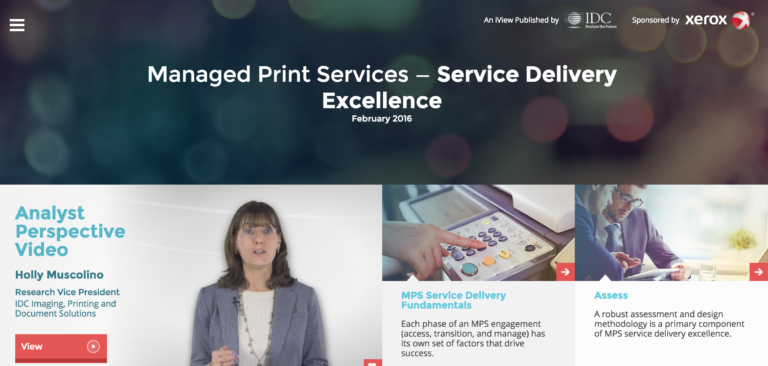How do you measure the value of global service delivery? A good program brings return on investment in more ways than you might think. The next time you’re talking with an MPS provider about the ongoing value of their service team, throw a few of these metrics into the mix. The best providers will know exactly what you’re talking about and can explain how they deliver that value.
Where Does Your MPS Provider Add Value?
Here are 23 ways a good service team adds value to Document Outsourcing engagements. Ask your provider how they stack up against these Service Delivery metrics:
- Assessments – Capture a quantified snapshot of your current state, including end user requirements, document-intensive business processes, devices (vendor’s and others) and locations. Assessments must be robust, accurate, wide-ranging and consistent.
- Transition and change management – If the transition doesn’t go well, you’ve got a problem. Detailed, phased transition plans should include rationale for the change, schedules and regular communications – across all locations.
- Ease of integration – No one wants to disrupt existing systems in the process of deploying services and solutions. A good service team will run a smooth, pain-free integration.
- Quality of day-to-day service delivery – This is table stakes, but don’t assume all vendors are equal.
- Timeliness – This relates not only to service speed, but also to your business cycles and any seasonal impact. The right provider knows how to get the job done without getting in the way of your business.
- Global delivery ability – If your business crosses international boundaries, shouldn’t your service team, too?
- Understanding of your business objectives and industry – The more your service team “gets” your business, the better they can make recommendations to improve it.
- Infrastructure – Does your service provider have infrastructure in place for proactive monitoring to head off potential problems? Is this a global infrastructure? Is it based on recognized IT standards?
- Business Intelligence – Metrics and reporting give you an accurate picture of how document outsourcing is helping your business. Look for a vendor with an established approach to business intelligence, including tracking, measuring, reacting and reporting. Data should be collected from and accessible at all sites.
- Reduced paper and print volumes – We’re a long way from the paperless office, but we can still significantly reduce paper volumes. Service delivery professionals help you hit your goals and maybe even go beyond what you expect.
- Higher employee-to-device ratios – One measurement of an optimized fleet is a sensible number of users per device. Getting you to this point is Service Delivery 101.
- Device uptime and performance – Keeping your devices running is the name of the game, and it’s easily tracked and measured. The differentiator is providing recommendations to continually improve.
- Higher employee satisfaction – When employees don’t have to deal with device downtime and workflow delays, they are likely to be happier with their work environment.
- Reduced demand on IT – When you outsource document management, IT teams gain more time for innovation and managing your core business.
- Automated processes – When a service team uses automation to manage your contract, they know how to use technology to save time, increase accuracy, expand data capture and improve productivity.
- Cost savings and efficiencies – This is still the top driver for most outsourcing engagements. How well does the provider deliver on this promise? Do they continually look for new ways to save?
- Future state design – Look for a service provider that designs and maintains an ongoing innovation roadmap to guide intentional expansion based on ongoing evaluation of your business needs. And don’t forget the technology to back it up.
- Continuous improvement – Look for a provider who takes a long-term view and offers an innovation roadmap for print infrastructure and document workflows.
- Dependable, thorough collaboration and communication – A good service provider builds an intimate relationship with your organization, and enthusiastically and proactively communicates and collaborates.
- Employee productivity improvements – Because the service team is frequently in your business, they see how employees and processes work and can recommend ways to make them more productive.
- Improved information/document security – Security is top of mind for most enterprises and their IT departments. Document outsourcing vendors should come to the table with ways to make sure your information remains secure.
- Reduced risk and increased compliance – When document workflow is automated and digitized, it becomes easier to meet your compliance requirements and avoiding risk caused by document problems.
- Meeting environmental targets – From reduced paper and waste, to user behavior modification, service delivery can recommend actionable sustainability improvements.
Every Managed Print Service engagement involves service, but not all service delivery is the same. Use these points to make sure you choose the provider that will bring real value to your enterprise.




[…] servicios y tecnología que ayuda a las empresas a simplificar su forma de trabajar, ha establecido 23 métricas que las empresas deberían preguntar a su proveedor de servicios de impresión gestionados para […]